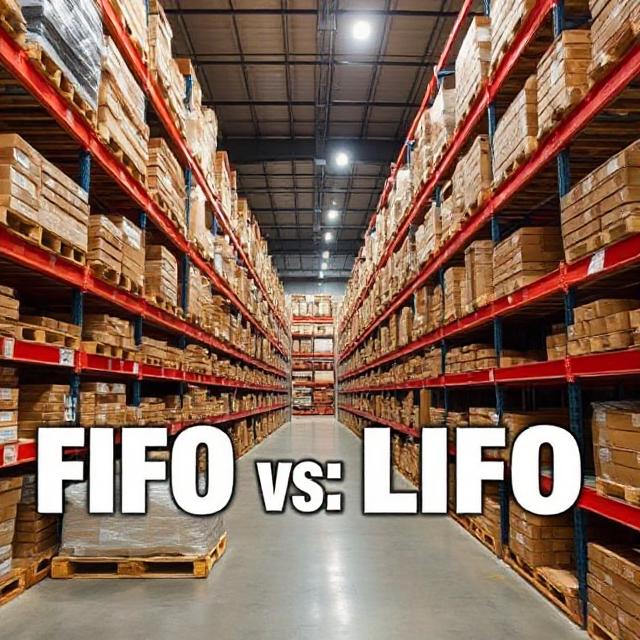Managing stock efficiently is essential for any retailer, wholesaler, or manufacturer. The way you track and move products directly impacts costs, profitability, and customer satisfaction. One of the most important aspects of inventory control is stock rotation—deciding which products leave your shelves first. Two common approaches dominate this process: FIFO (First-In, First-Out) and LIFO (Last-In, First-Out).
What is FIFO (First-In, First-Out)?
FIFO is a stock rotation method where the oldest inventory (the first stock purchased) is sold or used first.
Example:
If you buy 100 cans of soup in January and another 100 cans in February, under FIFO, the January stock is sold first.
Best for:
-
Food and beverage businesses
-
Products with expiry dates
-
Businesses aiming for accurate cost tracking
What is LIFO (Last-In, First-Out)?
LIFO is the opposite of FIFO. The most recently purchased stock (the last stock bought) is sold or used first.
Example:
Using the soup example, if you bought 100 cans in January and another 100 in February, under LIFO, you would sell the February stock before the January stock.
Best for:
-
Businesses in industries where prices rise quickly (e.g., raw materials, construction supplies)
-
Companies more concerned with tax benefits than product freshness
FIFO vs LIFO: Key Differences
| Aspect | FIFO (First-In, First-Out) | LIFO (Last-In, First-Out) |
|---|---|---|
| Stock Movement | Oldest items sold first | Newest items sold first |
| Best For | Perishable goods, retail, groceries | Non-perishables, industries with rising costs |
| Profit Impact | Lower cost of goods sold in inflation periods | Higher cost of goods sold in inflation periods |
| Taxes | Higher reported profits, higher taxes | Lower reported profits, lower taxes |
| Inventory Value | Closely matches actual market value | May undervalue older stock |
Advantages of FIFO
-
Minimizes Waste
Perfect for perishable goods like food, dairy, and beverages. Old stock gets sold first, reducing spoilage. -
Accurate Valuation
Inventory reflects current market prices, making financial reporting clearer. -
Simple to Apply
FIFO is straightforward and easier for small retailers to manage without advanced systems.
Disadvantages of FIFO
-
Higher Tax Liabilities
When prices rise, older (cheaper) stock is recorded as sold first, which increases reported profit—and taxes. -
Doesn’t Always Reflect Current Costs
Cost of goods sold may appear lower than replacement cost during inflationary periods.
Advantages of LIFO
-
Tax Benefits During Inflation
By selling the latest (and most expensive) stock first, cost of goods sold rises, lowering taxable income. -
Better Matches Current Costs to Sales
LIFO reflects current market costs in cost of goods sold, which can give a more accurate profit margin picture during inflation.
Disadvantages of LIFO
-
Not Suitable for Perishables
In food retail, older stock might expire if left unsold. -
Complex and Less Intuitive
Requires detailed record-keeping and can complicate accounting. -
Not Accepted Everywhere
International Financial Reporting Standards (IFRS) don’t allow LIFO, so it’s not widely used outside the US.
Which Businesses Should Use FIFO?
-
Grocery shops and supermarkets
-
Restaurants and cafes
-
Pharmacies (medications with expiry dates)
-
Wholesalers of perishable goods
Why? Because FIFO ensures older products move first, reducing losses from expired or spoiled goods.
Which Businesses Should Use LIFO?
-
Construction material suppliers
-
Oil, gas, and chemical industries
-
Businesses operating in inflation-heavy economies
Why? LIFO helps manage profits and taxes by aligning sales costs with current purchase prices.
FIFO vs LIFO: Which is Better for Small Shops in the UK?
For UK small retailers and wholesalers, FIFO is almost always the better choice. It ensures:
-
Fresh products for customers
-
Minimal waste and spoilage
-
Easier financial reporting
-
Compliance with accounting standards (since LIFO isn’t allowed under IFRS)
While LIFO can be beneficial for certain industries dealing with raw materials or inflation, most retail and wholesale businesses in the UK will find FIFO more practical and legally compliant.
How to Implement FIFO or LIFO in Your Business
1. Use Inventory Management Software
Modern POS systems can track stock movement and apply FIFO or LIFO automatically.
2. Train Staff in Stock Rotation
For FIFO, employees must place new stock behind older stock to ensure the oldest items sell first.
3. Regular Audits
Conduct routine stock counts to confirm rotation is happening correctly.
4. Analyze Data Regularly
Review sales and cost data to check whether your chosen method is maximizing profits.
FIFO vs LIFO in Practice: Example
Imagine a retailer buying 100 bottles of juice in January at £1 each and another 100 in February at £1.20 each.
-
FIFO:
-
January stock sold first.
-
Cost of goods sold = £1.00 per bottle.
-
Profit margin looks higher, but taxes also increase.
-
-
LIFO:
-
February stock sold first.
-
Cost of goods sold = £1.20 per bottle.
-
Profit margin looks lower, but tax liability decreases.
-
This example shows how the method chosen can influence both profitability and financial reporting.
Conclusion
When it comes to FIFO vs LIFO, the right method depends on your business type, location, and goals. FIFO is ideal for retailers, wholesalers, and anyone managing perishable goods, while LIFO works better for industries managing rising costs in raw materials.
For most UK small shops and wholesalers, FIFO is the best option. It’s easier, reduces waste, and aligns with accounting standards. By choosing the right stock rotation method, you can improve efficiency, cut costs, and keep customers happy.


